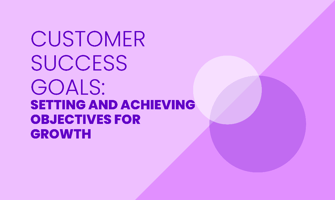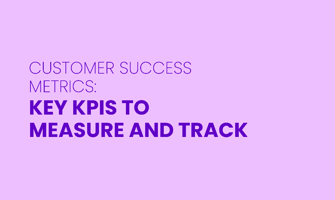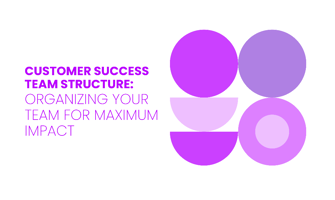Setting clear Customer Success goals helps companies grow. Align these goals with business...
The Ultimate Customer Success Playbook: A Comprehensive Guide to Best Practices
Just like top sports teams trust their playbooks to win, businesses can use customer success playbooks to keep clients happy.
These playbooks offer proven steps and strategies. They guide customer success teams in various tasks.
They help with:
Onboarding new customers
Solving problems quickly
Encouraging customers to buy more
By using these playbooks, your team can better align their goals with your clients' needs. This leads to better results and longer-lasting relationships.
Read on to learn how to build and use customer success playbooks effectively.
Understanding Customer Success
Customer success in an organization depends on aligning customer service and experience with business goals.
Key points include:
Having detailed customer success playbooks
Offering step-by-step guidance on customer interactions, from onboarding to renewal
These playbooks are often used by customer success teams in SaaS businesses. They provide clear strategies for:
Issue resolution
Escalation management
Crisis management
They ensure continuous improvement and customer satisfaction.
Organizations measure and track customer success using tools like Gainsight. They analyze customer feedback and CSAT surveys, conduct regular business reviews, and maintain active customer engagement through targeted strategies.
Aligning customer success initiatives with business goals helps build long-term relationships. It ensures that every customer touchpoint adds value and fosters customer trust.
Using customer segments and specific playbooks, like those focused on renewal or crisis, ensures tailored engagement and enhances customer relationships.
Success playbook templates guide teams through the customer journey. They help tackle challenges and drive exceptional results systematically.
Effective customer success management is important for growth and achieving business objectives. Successful customer interactions promote overall organizational success.
Why You Need a Customer Success Playbook
A Customer Success Playbook helps CS teams interact with and support customers in a consistent way. It provides step-by-step guidance for:
Onboarding
Customer engagement
Business reviews
Renewal processes
These playbooks help reduce churn rates and increase customer retention. They allow CSM teams to follow proven strategies and build long-term relationships.
A well-developed playbook also enhances the support team's efficiency. It standardizes responses to common issues, improving issue resolution and crisis management.
Including continuous improvement and customer feedback in these playbooks fosters growth and better customer satisfaction.
Organizing tasks and offering free success playbook templates can ensure excellent customer experiences. For example, GitLab and Gainsight show how positioning and discovery questions can make customer touchpoints more meaningful.
Using these tools in daily operations creates business value and builds customer trust.
Key Components of a Customer Success Playbook
Onboarding Playbook
The onboarding playbook offers clear steps to help new customers transition smoothly.
First, it sets out the goals and maps the customer journey to match the SaaS business's goals.
Customers get help with setting up their accounts and training sessions. They also receive resources like success templates and a help desk for quick support.
The playbook has strategies to handle common issues and improve customer interactions. This includes CSAT surveys and regular check-ins.
Important metrics like customer satisfaction and engagement levels are tracked using tools like Gainsight.
To keep improving, the playbook uses customer feedback and regular reviews. This supports long-term relationships and growth.
There are also tools for crisis and escalation management to keep customer trust and solve problems quickly.
This overall approach boosts the customer experience and ensures consistent results and customer success.
Escalation Management Playbook
The escalation management playbook for customer success outlines steps to handle customer service issues.
It provides detailed guidance on:
Identifying issues early
Monitoring specific customer touchpoints
Customer interactions are categorized by urgency. This helps CSMs prioritize tasks.
The playbook details response timeframes and communication protocols to maintain customer trust.
Responsibilities during each escalation phase are assigned to team members:
Frontline support handles initial problem discovery
Complex cases are escalated to senior customer success teams
Gainsight tools help track issues and ensure consistent follow-up.
Success playbook templates offer step-by-step guidance on:
Customer feedback collection
By using proven strategies for customer satisfaction and continuous improvement, the playbook helps businesses keep long-term relationships.
Marketing teams can use positioning information to align customer expectations. CSAT surveys measure customer experience throughout the process.
The playbook enhances daily operations and drives exceptional results and growth in SaaS businesses.
Post-Purchase Support Playbook
A Post-Purchase Support Playbook should outline clear steps to provide consistent and effective support.
Here are the steps:
1. --Map the Customer Journey--
Identify key touchpoints.
2. --Create Standard Procedures--
Set procedures for common post-purchase issues.
3. --Align Customer Success Managers--
Use customer success playbooks to guide interactions.
4. --Address Common Issues--
Implement escalation and crisis management strategies.
Use templates, like those from Gainsight or GitLab, to quickly respond to concerns.
5. --Establish Follow-Up Processes--
Schedule regular check-ins.
Conduct CSAT surveys to maintain engagement and trust.
6. --Continuous Improvement--
Use customer feedback and business reviews for growth and long-term relationships.
7. --Contract Renewal Playbook--
Provide a step-by-step guide to manage renewals and maintain satisfaction.
8. --Help Desk Tool--
Use a help desk tool to streamline daily operations and improve interactions.
With these playbooks, customer success teams can handle challenges efficiently, deliver great results, and build strong customer relationships.
Contract Renewal Playbook
When developing a contract renewal plan, consider customer feedback, satisfaction, and overall experience. Address concerns before renewal by talking to customers. Conduct business reviews and regular check-ins to understand their needs.
Customer success playbooks give step-by-step guidance for renewal processes. Track metrics like CSAT surveys, engagement rates, and renewal rates to measure success. This helps customer teams understand customer health and trust.
Effective strategies and tailored engagement help build long-term relationships and keep customers. Playbooks explain how to complete renewal tasks, gather information, and solve issues. Tools like Gainsight and GitLab help manage customer data, and help desk solutions streamline resolving issues.
These playbooks support continuous improvement and ensure daily operations meet high customer service standards. This drives growth and achieves great results for SaaS businesses.
Utilizing Playbooks for Different Customer Types
Playbooks are made to meet the specific needs of different customers. They consider unique challenges and goals.
Here are key considerations for making playbooks:
Understanding the customer journey.
Positioning the service or product effectively.
Gathering relevant customer feedback
Segmenting customers helps in making effective playbooks.
It allows customer success teams to create engagement strategies that are relevant. For SaaS businesses, this could mean:
Creating onboarding playbooks for new users
Developing renewal playbooks for long-term customers
Segment-specific playbooks boost customer satisfaction and trust. This improves the overall customer experience and relationships.
For example, GitLab can use success playbook templates to guide customer interactions. This includes resolving issues or conducting business reviews with metrics from Gainsight. Understanding customer touchpoints and using tools like a help desk helps in continuous improvement.
Companies can foster exceptional customer engagement and achieve growth by using playbooks like:
Crisis management
Escalation management
Contract renewal
These playbooks have proven strategies and detailed action plans. They help CSMs navigate customer interactions efficiently, driving great results and long-term relationships.
Creating Effective Playbook Templates
To create playbook templates for customer success, consider a few important elements:
Each playbook should have step-by-step guidance on customer interactions.
Include engagement strategies and clear objectives.
Make sure the template is customizable to fit different customer needs.
Use tools like Gainsight so CSMs can adjust playbooks for various segments and touchpoints.
Maintain consistency across multiple templates by sticking to proven strategies. These could be for resolving issues, guiding renewals, or managing daily operations.
Examples like GitLab's contract renewal playbook show best practices. They include discovery questions and information on positioning.
Regular improvement is important. Use customer feedback and CSAT surveys to evolve playbooks. This helps meet new challenges and deliver great results.
Free success playbook templates can boost customer satisfaction. They nurture long-term relationships and build customer trust, especially in SaaS businesses.
For effective use, integrate playbooks with the daily operations of your customer success teams. Use help desks to streamline service and business reviews. This fosters a great customer experience.
Crisis Management Playbook
When a crisis happens, the team should look at the Crisis Management Playbook right away.
First, a crisis response team does a quick check.
Communication should be clear and timely, both inside and outside the team.
Inside, share clear instructions and updates with all Customer Success Managers (CSMs).
Outside, inform customers about the crisis, what steps are being taken, and when they can expect a resolution.
Follow the escalation path based on the playbook.
For example:
Issues affecting many customers or major customer points are urgent and go straight to senior management.
Less impactful issues follow regular resolution steps.
During this time, use engagement strategies and listen to customer feedback to change actions quickly.
After the crisis, do a business review and use CSAT surveys to find ways to improve.
Use tools like Gainsight to track data for better issue resolution and long-term customer satisfaction.
This approach strengthens customer relationships and boosts customer success in SaaS businesses.
Playbooks and templates help guide the team through tough situations.
Using Mobile Apps for Customer Success
![]()
Mobile apps help improve the customer onboarding experience. They offer step-by-step guidance with tutorials and personalized checklists. Apps make customer interactions easier with real-time notifications, helping users navigate their journey smoothly.
Effective apps should have features for managing customer issues. This includes automated issue resolution tracking, direct access to customer service teams, and issue management protocols. These features maintain customer trust and satisfaction, even during tough times.
Mobile apps also provide ongoing support after purchase. They give access to help desks, business reviews, and feedback systems. Customer success teams can gather feedback, segment customers, and personalize engagements, fostering long-term relationships.
Including customer success plans ensures consistent touchpoints, aiding in renewals and growth. With proven strategies and templates, SaaS businesses like GitLab can deliver excellent customer experiences and engagement.
Tools like Gainsight allow apps to track customer interactions and satisfaction surveys. This helps maintain high levels of satisfaction and continuous improvement.
Leveraging Social Media for Customer Success
Companies can use social media to monitor customer satisfaction. They can check for comments, reviews, and direct messages. This helps identify areas for improvement in their Customer Success Playbooks.
Some best practices for addressing customer feedback include:
Responding quickly
Offering help desk support
Providing useful information to resolve issues
Proactive customer engagement strategies can include:
Sharing valuable content
Running polls
Asking discovery questions to understand customer needs better
Social media can help foster long-term relationships through continuous engagement and CSAT surveys. Integrating social media insights into Customer Success Playbooks helps SaaS businesses build customer trust and improve interactions.
For example, companies like GitLab have playbooks with step-by-step guidance to manage customer touchpoints and enhance the adoption journey. Addressing challenges promptly can drive growth and customer satisfaction.
Tools like Gainsight can automate and track social media interactions. This supports daily operations, escalation management, crisis management, and issue resolution. Sharing playbook templates and free resources can also build trust and engagement.
These actions help customer success teams gather valuable feedback, optimize business reviews, and improve contract renewals.
Free Tools and Resources for Customer Success
Popular free tools for enhancing customer success include:
Success playbook templates
CSAT surveys
Help desk solutions
These tools help businesses improve their customer service and engagement strategies.
SaaS businesses can use these resources to build customer success playbooks. These playbooks provide step-by-step guidance for customer interactions. For example, Gainsight and GitLab offer templates to map the customer journey. This can help businesses position their services better and improve customer satisfaction.
Free platforms with customer feedback mechanisms and business review tools enhance customer trust. They help ensure timely issue resolution and continuous improvement of services.
Free crisis management and escalation management resources help customer success teams handle challenges efficiently.
Marketing strategies from free resources aid in targeting specific customer segments. This leads to exceptional growth and better customer engagement.
By using discovery questions and proven strategies daily, businesses can optimize every customer touchpoint.
Implementing Email Support Software
When choosing email support software for a business, look for these features:
Seamless integration with CRM systems like Gainsight and GitLab.
Strong tools for managing escalations.
Efficient ways to resolve issues.
The software should track customer interactions across all touchpoints to keep service consistent. To link email support software with a CRM, a company can use APIs and built-in connectors. This allows smooth data flow and unified customer engagement.
The support team needs good training. This includes:
Step-by-step guidance on using success playbook templates.
Managing customer segments.
Escalating issues.
Conducting CSAT surveys.
Using crisis management techniques.
Ongoing training should focus on strategies to boost customer satisfaction and trust. Helpful resources include:
Help desk content.
Discovery questions.
Business review templates.
Gather and analyze customer feedback to refine engagement strategies and achieve strong growth. This helps address challenges and ensures customer success.
Setting Up Google Collaborative Inbox for Support
Setting up a Google Collaborative Inbox is simple with these steps:
A CSM should create the inbox in Google Workspace. This will centralize customer interactions.
Configure permissions next. Assign roles like "Manager" or "Collaborator". This helps teams handle emails better.
Each team member can use their role to access, track, and respond to emails. This boosts customer satisfaction.
For better organization, sort emails into categories such as "Resolved," "Pending," and "Urgent." This can streamline issue resolution and build customer trust.
Regularly update labels and categories based on customer feedback. This helps in continuous improvement.
Use success playbook templates for common responses. Conduct periodic business reviews to maintain long-term relationships.
Measure effectiveness with CSAT surveys. Track metrics through tools like Gainsight.
Establish clear engagement strategies, such as escalation and crisis management. This helps address customer challenges quickly.
A help desk tool can further support these operations.
It ensures that customer interactions are handled efficiently.
Following these steps will lead to great results in customer engagement and satisfaction.
Measure and Improve Success Metrics
To measure customer success, track KPIs like customer satisfaction, engagement, and feedback. Use playbooks with step-by-step guidance for handling customer interactions.
Data analytics tools like Gainsight can help improve these metrics. For example, analyze CSAT survey results and customer touchpoints to find areas needing improvement.
Strategies like escalation and crisis management help resolve issues and maintain customer trust. Continuous improvement comes from business reviews, proven strategies, and tailored engagement for different customer segments.
Free playbooks offer great guidance that fits the customer journey. SaaS businesses, like GitLab, can create positioning statements and discovery questions to ensure proactive service. This enhances long-term relationships and drives growth.
Address challenges with detailed renewal processes and help desk data. This will optimize customer success and secure great results.
FAQ
What is customer success and why is it important?
Customer success is the process of ensuring customers achieve their desired outcomes while using a product or service. It is important because it leads to higher customer satisfaction, retention, and advocacy. For example, offering proactive support and personalized guidance can enhance customer success.
What are the key components of a successful customer success playbook?
Clear customer goals and objectives
Proactive communication and engagement
Data-driven insights and monitoring
Scalable processes and automation
Regular customer feedback and adaptations
How can a company measure the effectiveness of their customer success efforts?
Companies can measure the effectiveness of their customer success efforts through metrics such as customer satisfaction scores, Net Promoter Score (NPS), customer retention rates, and upsell/cross-sell opportunities. Conducting regular surveys, analyzing customer feedback, and tracking customer engagement are also key indicators.
Why is it important for a company to personalize their customer success approach?
Personalizing the customer success approach enhances customer relationship and increases satisfaction. Tailoring solutions to individual needs and preferences shows care and understanding, leading to better retention and loyalty.
What are some common challenges companies face when implementing a customer success playbook?
Common challenges companies face when implementing a customer success playbook include lack of internal alignment, scalability issues, and resistance to change. These challenges can be addressed through clear communication, ongoing training, and executive buy-in.




